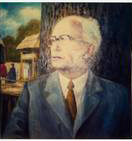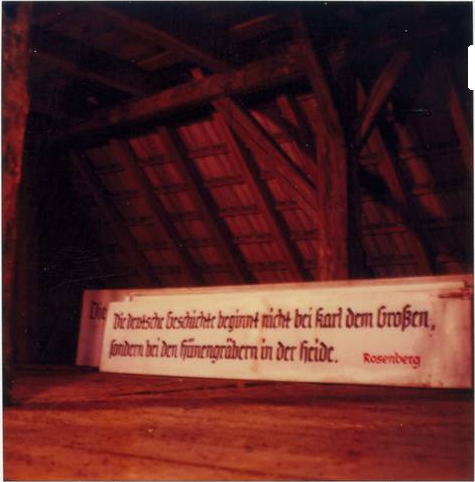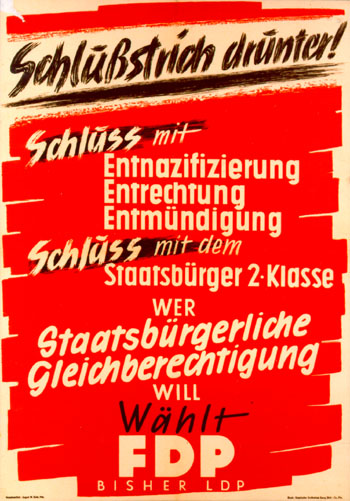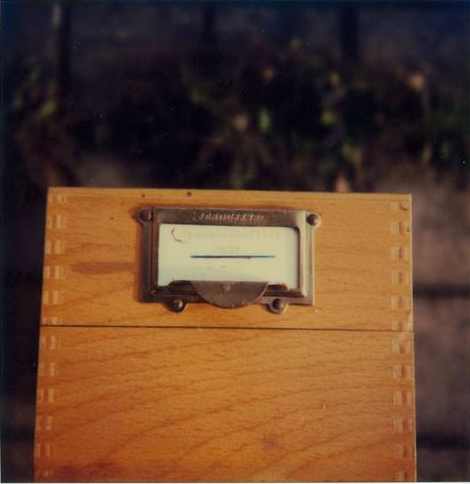A Nazi in the Pfahlbauten

source: polaristen.de / courtesy Tom Stern
The biography and professional career of Hans Reinerth (1900-1990) up to 1945 is illuminated by numerous sources that largely agree in terms of content and has been comprehensively processed by contemporary historians (see especially Bollmus 1970; Kater 1974; [1], summarized in Wikipedia. They draw the image of an initially very successful archaeologist who had acquired a certain reputation during excavations in southwest Germany and the neighboring Swiss cantons through new approaches to excavation technology and documentation methods, the use of natural sciences, coupled with aggressive public relations work [2]. However, his professional career was even more characterized by ruthless ambition and uninhibited opportunism. In 1932, as a result of an intrigue directed against his former teacher, the University of Tübingen found him "not worthy of the usual title of (...) professor" [3]. The reputation of the ambitious young academic was so damaged that his professional career appeared to be over.
Party official and perpetrator

Source: polaristen.de / courtesy Tom Stern
In this situation, Reinerth became a member of the Nazi Party[4]. His willingness to unconditionally subject the interpretation and presentation of archaeological finds[5] to party doctrines, defamation and denunciations of colleagues (“the extremely cleverly G. Bersu (Jew)”) (der überaus gewandte G. Bersu (Jude>[6] paved his way to high party and state offices. He was a central figure in the process of bringing antiquities associations, museums and university archaeological institutions into line (“Gleichschaltung) [7]. During WW II, Reinerth was responsible for looting and theft of cultural property as head of the “Special Staff for Prehistory and Early History” (“Sonderstab Vor- und Frühgeschichte”) in the “Reichleiter Rosenberg Operations Staff” (“Einsatzstab Reichsleiter Rosenberg”). According to his own statements, he “secured” collections in over 300 museums in the military-occupied Ukraine alone[8) uand thus became the perpetrator of a large-scale crime[9). After the collapse of the “Third Reich”, Reinerth was classified as one of the “guilty” in a tribunal trial (Spruchkammerverfahren)[10]. The reorganizing prehistorians from South and West German research excluded “the folkish-nationalistic prehistoric researcher (den völkischen Vorgeschichtsforscher) from the scientific community in 1949.[ .[11].
A lesson about post-war Germany
However, with the founding of the Federal Republic of Germany and the emerging Cold War, the political and legal circumstances changed quickly and fundamentally.

FDP (Freie Demomkratische Partei; a member in the present german government). Source: Wikipedia
The Nazi in the pile dwelling museum
Reinerth was not allowed to return to academic research or cultural heritage institutions. However, he was able to take over the open-air museum in Unteruhldingen at Lake Constance, which he continued to run as the “Museum of German Prehistory” until his death in 1990. The museum contents and their presentation developed during the "Third Reich" were at best cosmetically corrected after the war [18]. This did not harm the success of the museum. We have Reinerth's successor, G. Schöbel, to thank for numerous contemporary historical accounts, including descriptions of the museum's post-war years [19], so we know quite well about the constant increase in visitor numbers and the economic success that soon began. This also means that in the following decades, in the unbroken tradition of museum policy from 1933 onwards, hundreds of thousands of school children continued to be indoctrinated with Nazi jargon and folkish-nationalistic content [20]. Much else, however, remains open and sometimes contradictory. Throughout his life, Reinerth only partially met the requirements for scientific publications of his archaeological field work, so that we only receive information about his post-war activities cursorily and often only from obscure sources. These documents do not meet the basic requirement of any science, namely reproducibility and traceability [21]. This also includes the activities of a “Lake Constance research group”, for which we only know photos of scuba divers posing on the shore and three underwater photos [22] With this “research group”, which Reinerth recruited from one of his nazi era networks[23], he became a founding member and first president of the Association of German Recreational Divers VDST, of which he remains honorary president to this day. [24).
Forget it?
Which role did Reinerth play in the paralysis of pile-dwelling research on Lake Constance [25] between the mid-1950s and the mid-1970s? From the 1960s onwards, there was extensive dredging in the shallow water zones of Lake Constance, which resulted in the destruction of invaluable archaeological cultural assets [26]. Why didn't the cultural heritage authorities take action? If there were illegal archaeological ecavations, [27] why didn't the police and judiciary intervene? Were there old boy networks?
Source: polaristen.de / courtesy Tom Stern
1↑ R. Bollmus, Das Amt Rosenberg und seine Gegner. Studien zur Zeitgeschichte (Stuttgart 1970); M. Kater, Das "Ahnenerbe" der SS 1933-45. Ein Beitrag zur Kulturpolitik des Dritten Reiches (Stuttgart 1974; 4. Auflage Oldenbourgverlag 2006)
2↑ Werner Lustenberger, Wahr ist, was uns nützt! Zur Urgeschichte im Dienst der Nationalsozialisten. Argovia: Jahresschrift der Historischen Gesellschaft des Kantons Aargau 124 (2012), 100. https://doi.org/10.5169/seals-391287
3↑ Michael Strobel, Hans Reinerth und Gustav Riek – Modernitätsflüchtlinge in einer ungewissen Wissenschaft. Arbeits- und Forschungsberichte zur Sächsischen Bodendenkmalpflege 45, 2003, 449. https://www.academia.edu/7441304/Hans_Reinerth_und_Gustav_Riek_Modernit%C3%A4tsfl%C3%BCchtlinge_in_einer_ungewissen_Wissenschaft_Arbeits_und_Forschungsberichte_zur_S%C3%A4chsischen_Bodendenkmalpflege_45_2003_443_461
4↑ Gunter Schöbel, Hans Reinerth, (1900 – 1990) – Karriere und Irrwege einses Siebenbürger Sachsen in der Wissenschaft während der Weimarer Zeit und des Totalitarismus in Mittel- und Osteuropa Acta Siculica 2008, 154. https://www.yumpu.com/de/document/read/8537040/hans-reinerth-1900-1990-karriere-und-irrwege
5↑ z.B. das "Nordische Haus" in Hügel 2, Zigiholz, Nekropole Sarmensdorf CH - Lustenberger 2012 (Anm. 2), 104 und 111. - zur "germanischen Stammesburg" auf dem Odilienberg / Elsaß vgl. z.B. A. Bräuning, Gustav Adolf Rieth, Geograf, Bildhauer, Prähistoriker, Landeskonservator und Denkmalpfleger - ein etwas anderer Nachruf. Alemannisches Jahrbuch 2021/2022, 241 sowie Strobel 2003 (Anm. 3), 459).
6↑ Schreiben Reinerth an Rosenberg am 25.3.1932, zit. n. Schöbel 2008 (Anm. 4), Anm. 66.
7↑ Schöbel 2008 (Anm. 4), 159.
8↑ Schöbel 2008 (Anm. 4), 167.
9↑ Lustenberger 2012 (Anm.2), 107.
10↑ Strobel 2003 (Anm. 3), 443; Schöbel 2008 (Anm. 4), 168.
11↑ Schöbel 2008 (Anm. 4), 168.
12↑ vgl. z.B. Norbert Frei: Vergangenheitspolitik. Die Anfänge der Bundesrepublik und die NS-Vergangenheit. (München 2012).
13↑ https://www.bka.de/SharedDocs/Downloads/DE/Publikationen/Publikationsreihen/PolizeiUndForschung/Sonderband2011SchattenDerVergangenheit.pdf.
14↑ Klaus-Detlev Godau-Schüttke, Von der Entnazifizierung zur Renazifizierung der Justiz in Westdeutschland (6. Juni 2001), in forum historiae iuris, https://forhistiur.net/2001-06-godau-schuttke.
15↑ Schöbel 2008 (Anm. 4), 168.
16↑ Schöbel 2008 (Anm. 4), ebd.
17↑ Strobel 2003 (Anm. 3), 443; Schöbel 2008 (Anm. 4), 145.
18↑ Lustenberger 2012 (Anm. 2), 105; zuletzt: G. Schöbel, 100 Jahre Begeisterung für eine Idee. Plattform 30/31, 2021-22, Abb. 21.
19↑ vgl. Publikationsliste Schöbel.
20↑ vgl. G. Schöbel, Die Pfahlbauten von Unteruhldingen. Teil 2: Die Zeit von 1930 - 1935, 28 mit Schöbel 2023 (Anm. 18), 39; Lustenberger 2012 (Anm. 2), 105. Ich selbst (M. Mainberger) habe noch in den 1980-er Jahren Texte und Inhalte zu "nordischen" und "westischen" "Kulturen" gesehen.
21↑ G. Schöbel, Spätbronzezeit am Bodensee. Taucharchäologische Untersuchungen in Hagnau und Unteruhldingen 1982 - 1989. Siedlungsarchäologie im Alpenvorland IV (Stuttgart 1996), 23.
22↑ G. Schöbel, Frühe taucharchäologische Untersuchungen im Verband der Deutschen Sporttaucher. Ein Rückblick auf die 1950er Jahre. Skyllis 14. Jg. 1914/2, Abb. 6; Abb. 13. Hier (S. 185) wird das Gründungsjahr der "Forschungsgruppe" mit 1954 angegeben. Schöbel 2008, 169 gibt 1956 als Gründungsjahr an.24↑ www.vdst.de/ueber-uns/ansprechpartner/praesidenten-ehrenmitglieder/ H. Schlichtherle, Pfahlbauten rund um die Alpen. In: H. Schlichtherle (Hrsg), Pfahlbauten rund um die Alpen (Stuttgart 1997), 8.
26↑ Irenäus Matuschik, Adalbert Müller, Befunde der taucharchäologischen Untersuchungen 1978 - 2012 in Sipplingen. In: Die Pfahlbausiedlungen von Sipplingen - Osthafen am Bodensee I. Befunde und dendrochronologissche Untersuchungen Band 1. Siedlungsarchäologie im Alpenvorland XV (Wiesbaden 2023), 25.
28↑ Lustenberger 2012 (Anm. 2), 106; Schöbel 2008 (Anm. 4), 160 und Anm. 102.
29↑ Vgl. z.B. den Nachlass E. Wahle in der internationalen Datenbank für Nachlässe, Autographen und Verlagsarchive Kalliope, die zahlreiche Prähistoriker-Nachlässe erschließt.
